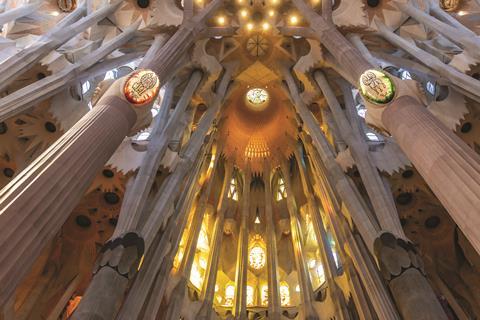
When I walked into Liverpool Cathedral a few weeks ago, I audibly gasped. Stepping inside the magnificent building, I was taken aback by its awesomeness. Built between 1904 and 1978, it is the largest cathedral in Britain and the eighth largest church in the world.
I have always loved cathedrals. To me, they represent that ‘thin space’ between heaven and earth; reflecting God’s glory but inviting us into it. They are meeting places of the spiritual and the physical realities in which we exist as human beings who are made in the image of God. They mark those moments when those two spaces join hands.
Every time I step into the Basílica de la Sagrada Família in Barcelona (pictured above), I’m bowled over by its sheer beauty and ethereal atmosphere; the colours, and the places where the light hits the darkness, are like nothing I’ve seen before. It’s like seeing God through the eyes of Gaudi. I sense the same thing when I walk into any cathedral, or into a quiet church in a rural village in the British countryside.
This Christmas, many who do not normally attend church will find themselves wandering into our church buildings. Some will marvel at the architecture and geek out on the history. Others will find themselves awestruck, just like I do. As we have been faced with our own mortality and the devastation wrought by the Covid-19 pandemic, the past year and a half has caused many to ask deeper questions about the meaning of life. Some have lost loved ones and livelihoods. Some have found themselves wrestling with where God has been in all of this. As Christians, how do we answer these questions? How do we speak hope and life into this present darkness?
Over the coming years, there will be fewer opportunities for people of all faiths and none to find themselves wandering into our churches, as an increasing number are set to close. According to the National Churches Trust (NCT), the number of churches open for worship has dropped from 42,000 to 39,800 in the past ten years, with inner-city areas most affected. The NCT’s vice-president, Michael Palin (of Monty Python fame), has backed their Future of Churches campaign, which highlights “the community, economic, heritage and spiritual benefits of churches”.
For most people, the idea of holy ground is meaningless. Nevertheless, millions of people visit the UK’s 42 cathedrals each year. And visitor numbers are increasing, despite decreasing congregation numbers. People come to look at beautiful architecture that hints at a creative God, to hear music that speaks life to an emptiness within; to gather with others because, for some reason, life feels better when they are not alone. They come to stand, to sit, to kneel, to pray, to reflect, to listen, to pause, to be still. Cathedrals – and all of our beautiful church buildings give people a taste of God’s presence.
I believe these spaces are ones we should all support this Christmas.




































